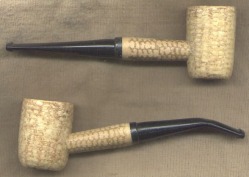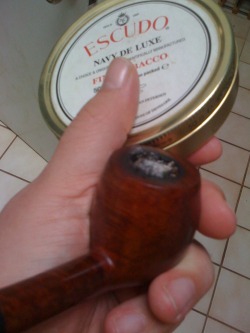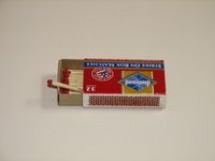Why do pipe smokers enjoy smoking pipe tobacco?

There are as many answers to that question as there are pipe smokers! Most seasoned pipe smokers enjoy smoking pipe tobacco because of the calming effect is has on so many of us. It is a contemplative pastime that gives us a chance to slow down and savor the moment. I could be wrong, but I'm willing to bet this is also the reason some people don't like smoking pipe tobacco. Pipe smoking requires a lot of patience and effort.
Like playing a musical instrument, one doesn't master it in a day, a week, or even a year. The new pipe smoker must discover what kinds of pipe tobacco suit him or her, he must learn to properly fill the pipe, light it, and there is even a considerable amount of technique involved with simply smoking pipe tobacco. Tobacco pipes need care - they must be stored properly and cleaned regularly. Proper maintenance of a quality briar pipe guarantees lifetimes of use.
Once again, these are thing things that turn some people away from smoking pipe tobacco while creating hours of pleasure for those who love smoking pipe tobacco. If you think you might belong among the pipe smokers and want to give pipe smoking a try, figure out why pipe smoking isn't going well for you, or even see if you can pick up something new to add to your bag of tricks, read on.
Pipe Smoking Tools of the Trade

Smoking pipe tobacco requires a few purchases. Of course, you'll need a pipe, some pipe tobacco, and a lighter or matches.
One thing to remember - and if you take nothing else from this article, I beg you to always keep this in mind:
Take it slow and easy. Don't rush, don't go overboard, and don't try to hard. Remember, smoking pipe tobacco is like playing an instrument. You don't master it the first day. If you haven't already made your first purchases of a quality briar tobacco pipe and some pipe tobacco, remember not to rush into it when you make your first purchases. With that out of the way, I'll start with the shopping list and explain what to look for in a pipe and your first pipe tobacco blends.
Picking out your first pipe

Would you believe me if I told you that you can buy a perfectly suitable tobacco pipe for less than ten dollars? It is true, and if you are new to smoking, that is what I recommend you do.
Corn Cob Pipes
What you'll want to buy is a corn cob pipe. Missouri Meerschaum is one of the most popular brands of corn cob pipes and they are readily available. These are not toys. There are a number of veteran pipe smokers out there who remain very fond of their corn cob pipes and continue to smoke them regularly not because they can't afford better tobacco pipes, but because they know cobs make excellent pipes in their own right and enhance their enjoyment of smoking pipe tobacco.
You may decide that for whatever reason, a corn cob pipe just is not for you. That's ok. You should love everything you know about a pipe before you spend money on it. A pipe is an investment no matter what the price so choose your first tobacco pipe wisely.
Briar Pipes
If you choose to make a briar your first pipe, you'll be spending more than $10. Plenty more in fact. What I am about to share is only my opinion, but you'll probably need to spend at least a minimum of $50 on a pipe you can count on to smoke well. Smoking pipe tobacco in a poor pipe is not a pleasurable experience. If you buy a briar pipe for $15 you may have saved yourself $35 or more on the pipe, but your chances of giving up on pipe smoking altogether due to consistently bad experiences will be a waste of not only the $15 spent on the cheap pipe but the money you spent on pipe tobacco as well.
Estate Pipes
One thing to look for is an estate pipe. What, you ask, is an estate pipe? It is a pipe with a previous owner. Someone else has already smoked the pipe. You may be recoiling already. The though of putting something in your mouth that has been in a stranger's mouth does not appeal to you. Do you eat in restaurants? That silverware you're eating with has been in more mouths than an estate pipe, and just like silverware in a restaurant, estate pipes can, and usually have, been carefully and thoroughly cleaned and sanitize.
A benefit of buying an estate pipe is they are already broken in. That is the good news. The bad news is, you aren't going to save a lot of money by buying an estate. This may not make sense, but I have a few reasons. First of all, the estate pipe market is huge and there is plenty of demand. Secondly, if you spend less that $50 on an estate pipe, you are likely getting a used version of that $15 disaster I warned you about earlier.
Estate pipes got their name because they usually came from an estate sale, some old brother of the briar moved on to a better place and left his collection of pipes behind to be grabbed up by a bargain hunter. These days, most "estate pipes" are pipes someone is removing from their collection to make room for other, better tobacco pipes. One thing to keep in mind when shopping estate pipes is that people don't usually sell their favorite, best-smoking pipe.
Choosing pipe tobacco

Personally, this is my favorite part of pipe smoking -the tobacco. I love trying blends I have never tried before and taking comfort from my old favorites. Unfortunately, there is a lot of really poor "conventional wisdom" on suggesting pipe tobacco to the beginning pipe smoker.
Too many well meaning tobacconists and fellow pipe smokers will automatically steer the beginner towards cheap aromatic tobaccos. Let me make one thing perfectly clear. There are no training wheels when it comes to smoking pipe tobacco! There are pipe tobaccos you'll like and others you won't. It all depends on your personal taste, and the best way to find out what suits you is experiment.
Another bit of advice - you can't tell much about how a tobacco will taste by smelling it in the canister. Sure, you can distinguish between a cherry flavored blend and mixture that contains a generous portion of Latakia, but that's about it.
My suggestion is to look for a sample pack or a tobacconist that will sell you one-ounce portions. Most will be happy to.
Here is a brief run-down of the major types of pipe tobacco:
Aromatics
Again, too many think of aromatics as a training wheel tobacco that beginners start with and graduate from. The truth is, there are a lot of high quality aromatic pipe tobacco blends available that have been loved by a multitude of pipe smokers, including myself. That said, like any other genre of pipe tobacco, there are some that are better than others according to the pipe smoker's taste.
English Blends
When I use the term here, I am talking about a blend that has no flavoring added - the flavor is entirely from the condiment tobaccos included in the blend. These will usually have some portion of Latakia which has a woodsy, leathery, smokey taste. They usually contain Oriental tobaccos too, which add a rich, spicy flavor. There are many in this genre to choose from.
Virginias and Virginia-Perique
This type of tobacco isn't necessarily grown in the state of Virginia - it refers to a type of tobacco grown worldwide. Virginias are naturally sweet and tangy. Perique is often added to Virginia to give the pipe tobacco some peppery spice and bring out the sweetness of the Virginia. While I wouldn't disuade a beginner from experimenting with a Virginia blend, I will caution you that Virginias, more than other types of tobacco, can leave your mouth sore. Smoke these especially slowly and carefully.
Burley
Burley is another type of tobacco and usually acts as a base in an aromatic or English blend. Burley offers a deep, nutty, sometimes earthy flavor. Look for any quality blend with burley in it.
Over the counter
Throughout your life, you have probably noticed the tobacco available in grocery and drug stores. Don't sell these short. Give one or two a try at some point. There is a good reason most of these have been around for decades and decades.
More things you'll need

Matches or a lighter - nothing fancy, any lighter will do, but wooden matches are probably your best bet. Avoid paper matches.
Pipe cleaners - make sure you get the real thing - the ones that are white and intended for cleaning pipes, not crafts. You need to use these on your pipe throughout and after each smoke to keep your pipe clean and dry.
Tamper or pipe tool - a nail with a wide head will do and inexpensive pipe tools are easy to find. These are for flattening the ashes in your pipe as you smoke and carefully removing dottle after.
Packing your pipe and lighting
Loading the pipe
Finally! Unlike a lot of guides that you'll find which talk about layers and fancy methods, I'm going to save you some frustration by skipping to telling you what you need for an end result - you can figure out the steps to achieve it. What you want is the bowl of the pipe filled with tobacco not too tightly, and not too loose. The particles of tobacco need to rest close enough to each other the ember will spread as you smoke, but if they're packed too tightly they won't get enough oxygen and the pipe will go out too fast. Learning to pack it "just right" only comes from experience.
You will get it wrong a lot your first month smoking pipe tobacco. This is where that patience I told you about earlier comes in. After filling your pipe, draw air through it before lighting. Now is the time to make sure there are no blockages. You are also checking against too much resistance - if you notice a lot of resistance in the draw, you packed it too tight.
Lighting your pipe
Lighting is another thing you need to do slowly. Conventional wisdom calls for a charring light followed by an actual light that will take you to the bottom of the bowl. Hogwash. Here is how you do it:
Draw very gently with the flame circling above the surface of the tobacco. While moving the flame around the surface, gently draw three times, just enough to quickly dance the flame down to the tobacco. Extinguish the flame and with a feather touch, tamp what very few ashes there will be down. You should still see unlit tobacco.
Carefully repeat the process just as above, this time more will catch. Only three touches of flame to tobacco, then a very light tamp to flatten the surface. You'll repeat this several times before getting to the point where you have an evenly lit surface - an ember that covers the entire bowl.
Smoking the pipe tobacco
You'll be tempted to puff away in order to keep the ember going. Don't. Take very slow, gentle draws on the pipe - easy does it. Don't worry about the pipe going out. It is natural. Spend some time around pipe smokers and you will likely hear boasting about smoking a pipe down to the heel with one match. That day will likely come, but it isn't something worth obsessing about. Above all you want to enjoy yourself. Don't be afraid to put the pipe down and let it go out for a rest after a few minutes of smoking, especially as a beginner. There is no rule that says you have to smoke an entire bowl in one sitting.
More research - let the journey begin

This has been nothing more than an introduction. Hopefully enough to get you started.
The fun comes with continued research and interaction with other pipe smokers. We never stop learning. We are always and forever exchanging tips, suggesting blends, discussing pipes, and learning more about this fantastic hobby.
If you are looking for a place online to continue your journey, I heartily recommend a site aptly called Smoking Pipe Tobacco. There you'll be able to read more articles about pipe smoking, research and read about pipe tobacco blends, and get in touch with more pipe smokers who can answer questions and offer more tips and advice.
Also, feel free to contact me directly through this site or by following me on Twitter. My handle there is smoking_a_pipe.
And remember - take it slow, and enjoy yourself!
